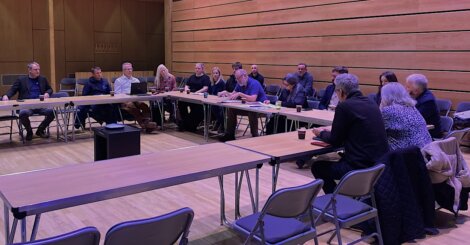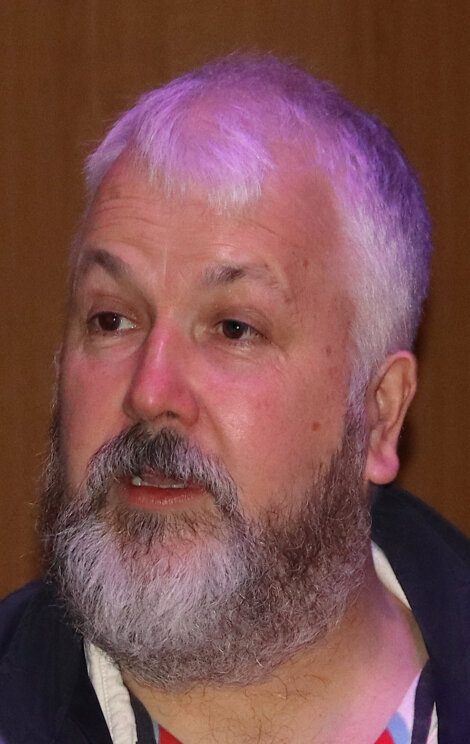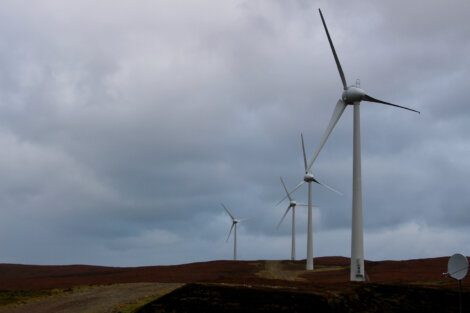Energy / Call to slow down the ‘SSE/Statkraft juggernaut’
- Existing local electricity producers fear they could be ‘switched off’
- But SSEN says new Gremista grid access point is a ‘positive change’
- Concern over a possible Viking phase two
Photo: Shetland News
SOME operators of locally owned renewable energy projects have warned they could go out of business unless SSEN gives a guarantee that their feed-in status to the local grid is maintained.
The concern comes as local producers say they have been receiving mixed messages from SSEN Distribution and SSEN Transmission over their ‘ranking’ once the Gremista supply point will be switched on, likely in the first quarter of 2026.
Alice Mathewson, the development manager of the North Yell Development Council, the community enterprise that owns the Garth wind farm, and owner of the North Hoo Fields wind turbine on the outskirts of Lerwick, Angus Grains, expressed their concern during the launch of the Just Transition Commission report on Shetland earlier this week.
But SSEN sought to allay those fears in a statement today (Thursday) by saying the new set-up would enable local producers to export “unconstrained to the distribution network”.
Grains and Mathewson both said they had received conflicting messages from SSEN how local projects would be ranked once Viking – and the national grid through the new 600MW subsea cable which runs to Caithness – is connected to the local grid via the Gremista supply point.
Mathewson said: “If the grid supply point is put above us, we would be continually switched off because they have so much capacity, and that would put us out of business.”
Grains said the Gremista grid supply point (GSP) was originally designed to ‘support’ Shetland’s energy needs but had now changed now to ‘supply’ Shetland’s energy needs.
Become a member of Shetland News
“Since then, there has been a determined effort to push the GSP connection further and further up the grid in Shetland, and if SSE had their way we would be stuffed out,” he claimed.
“And it has yet to be proven that we won’t be. I think this is an appalling state of affairs.”
Mathewson said: “The energy we produce is absolute peanuts compared to the likes of SSE [and the future Statkraft wind farms in Yell and the outskirts of Lerwick], but to us, to our community and to Angus’ business, it is life or death.”
Asked to give a guarantee that small operators will continue to be able to feed into the grid and on the same conditions, SSEN told Shetland News that the connection to the Gremista grid supply point “will be a positive change for existing generators”.
A spokesperson said: “Due to the move of Lerwick Power Station to stand by operation, our analysis shows that curtailment levels will be significantly reduced with NINES generators able to export unconstrained to the distribution network, apart from instances of extreme low demand, as seen during COVID, and during outage conditions.
“We conduct regular engagement with the generator community and will reiterate this position during future discussions.”
However, in response Grains said this morning that he continued to have reservations and claimed that supporting local generation was merely an afterthought in the whole Shetland energy set-up.
As far as he was aware the new access arrangement was still at the design state, Grains said, and in order to run a business, he and all the other small producers needed to receive a written guarantee.
All existing small generators such as Garth, Luggies Knowe, Hoofield North and Nova connect to the local grid via the NINES active management network (ANM). Burradale wind farm as a ‘firm’ connection as it was the first.
As such none of these projects are entitled to receive any constraint payments as these are only made when contracted to SSEN Transmission and not SSEN Distribution which is responsible for the local network.
These concerns about local connection constraints have also been highlighted in an update on the draft Shetland energy strategy prepared for Wednesday’s full council meeting.
Meanwhile, both Grains and Mathewson described the Just Transition for Shetland report as well-meaning but too little too late and added that it needed to be a far more hard-hitting document.
They said they were left with a sense of powerlessness at the current situation and warned that there was a danger of their own developments being “switched off”, adding that there would also be no grid capacity left for community projects.
“We don’t have the power,” Mathewson said. “The reports are well-written but it is too late.
“We want to see real action, and not just from the developer but also from government, and that is not happening.”
Grains said: “There is a juggernaut going through just now, a huge SSE/Statkraft type juggernaut, and we [Shetland and its political leadership] just don’t want to apply the resources to at least slow it down.”
He also predicted that Shetland could easily see phase two and three of Viking long before any of the proposed offshore wind projects to the east of the isles would be built.
“If Shetland gets the second cable, and some of these offshore proposals don’t happen because they are not viable, then we will be getting Viking two and Viking three,” he said.
“Watch this space. We have to make sure that the noise is ongoing, so that Shetland gets a better deal.”
Become a member of Shetland News
Shetland News is asking its many readers to consider paying for membership to get additional features and services: -
- Remove non-local ads;
- Bookmark posts to read later;
- Exclusive curated weekly newsletter;
- Hide membership messages;
- Comments open for discussion.
If you appreciate what we do and feel strongly about impartial local journalism, then please become a member of Shetland News by either making a single payment, or setting up a monthly, quarterly or yearly subscription.



























































